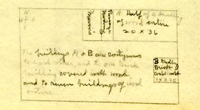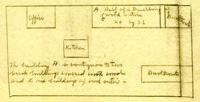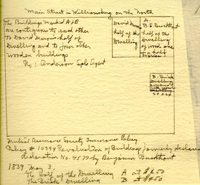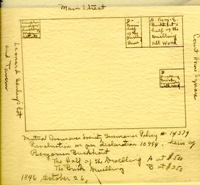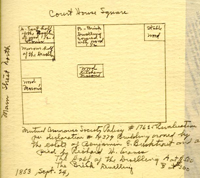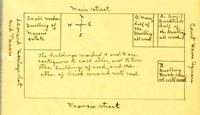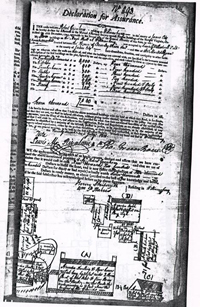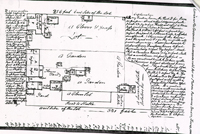John Greenhow House Historical Report, Block 13-2 Building 23E Lot 160Originally entitled: "Repiton House Block 13 - Colonial Lot 160 North"
Colonial Williamsburg Foundation Library Research Report Series - 1257
Colonial Williamsburg Foundation Library
Williamsburg, Virginia
1990
Repiton House Greenhow-Repiton House
(Block 13 - Colonial Lot 160 North)
February, 1947
LOCATION:
The house known as"The Repiton House"is located on lot 160, which lies on the south side of Duke of Gloucester Street. Its other bounds are Market Square to the east; the Colonial Prison to the south; and the property once occupied and owned by Robert Greenhow to the west.
PROBLEM:
As the Repiton property is located in James City County, it is not possible to assemble complete records concerning it because of the destruction of the Court records during the Civil War. However, information relative to these lots has been found in the tax records, Southall Papers, and Mutual Assurance Society insurance policies.
HISTORY:
The earliest available record of the Repiton House is the Frenchman's Map (c. 1782). On this eighteenth-century map a house, which appears to be located on lot 160 is shown. (See Illustration #2 of the Appendix for drawing from the Frenchman's Map.)
The first record we have found as to the ownership of this lot indicates that it belonged to John Greenhow,1 merchant in Williamsburg. Greenhow operated a store"near the Church in Williamsburg"at which place he offered fine blankets, cottons, rugs, imported leather, boots, spices, etc.2 (Virginia Gazette, September 19, 1766; March l2, 1767; December 3, 1767; -2- and September 9, 1773.) Tax records for Williamsburg indicate that Greenhow paid tax on 4 lots from 1782-1786 (see Illustration #1 of the Appendix).
Upon the death of John Greenhow, his son, Robert Greenhow, was the sole executor of the will and apparently sole heir to the property:
"WILLIAMSBURG, September 24, 1787.
"agreeable to the last will and testament of Mr. JOHN GREENHOW, late of this city, will be told at public sale, an Thursday the 18 of October...all the real and personal estate of the deceased...consisting of large and commodious Dwelling house on the main street...
ROBERT GREENHOW, sole executor" Virginia Gazette and Independent Chronicle, John Dixon, ed.)
In 1788, tax transfers for Williamsburg give: "Robert Greenhow 4 lots via John Greenhow." In 1791, Robert Greenhow is shown on the tax records as paying on 4 lots. Also, the same tax was paid by Greenhow in 1800. In 1801, Greenhow paid tax on 6 lots. (See Illustration #1 of the Appendix.)
An insurance policy, issued by the Mutual Assurance Society indicates that policy #493 was made out to Robert Greenhow on July 27, 1801. Greenhow, in this policy, insures all the houses on his two lots (undoubtedly lots 159 and 160). The dwelling house (later known as the Repiton House), 31 feet by 21 feet, was valued at $560. (See copy of policy, Illustration #3 of the Appendix.) In settling the values and amounts, Greenhow, in a letter to W. Ast of the Mutual Assurance Society, gave pertinent Information about his property in Williamsburg and at the same time enclosed a drawing with notes as his lots. (See Illustration #3 of the Appendix for copy.) He writes Ast:
"...after critically viewing the property (a plan of which on a scale of forty feet to the Inch, accurately drawn is annexed) 'have declared that it would cost in Cash 9200 Dollars in ready money to build the same; and is now, (after the deductions of 2200 Dollars for Decay or bad repair) actually worth 7000 Dollars in ready -3- money'...The situation of my buildings are such as to place them in little or no Danger of fire from my Neighbors; The main Street is nearly 100 feet wide; to the west, 70 or 80 feet separates me from the next building; To the East I am perfectly secure, 12 or 1500 feet intervening of vacant Ground. To the South no buildings exist." (Photostat copy, Department of Research. )
In this letter, Greenhow valued his buildings as "Dwelling house F---$1500 but actually worth $560." This apparently was the Repiton house. (See a drawing in Illustration #3 of the Appendix.)
MAPS
A study of the Bucktrout Map (1803) shows the name "Greenhow" on lots 159 and 160. The Unknown Draftmans Map or College Map (1791) gives the name "Greenhow" on the same lots though no lot numbers are indicated.
An insurance policy of Louis Girardin's,1 dated May 25, 1806, describes the dwelling as "Contiguous within 30 feet of 4 wooden houses and 1 brick covered with wood." The dwelling marked "E" is 1 story high built of wood 30 x 20, with a shed 30 x 16 also of wood. The building is situated on the east side of the lot adjacent to the Market Square. (See policy #664, Insurance Book, Department of Research.)
Greenhow, on April 5, 1810, insured the property recently acquired from Louis Girardin. He designated the house on the lot as"my building on the Court House square now occupied by Joseph Repiton2 situated between -4- the lot of John P Shields on the West - the Market Square on the east and on the north and south by parts of the same lot on which it stands in the county of James City..." (Policy #1022, Insurance Book, Department of Research. No drawing given.) It is significant that Greenhow said the house was occupied by Repiton. A notation at the bottom of the policy, apparently written two weeks later, shows that Greenhow had sold the house and lot to Mr. Joseph Repiton:
"...Having Sold to Mr Joseph Repiton, the lot & the Improvements on which this brick house is Erected for value by me Received All the Advantages Accruing in Case of Conflagration are consequently Attached to him--Wmsburg April 19th 1810
Ro. Greenhow---"
Other insurance policies issued for the Shields property (lot 159) in August 1811 designate the Repiton property as "to the west of Court House Green." (Insurance Book, Department of Research.) Repiton insured his own house and lot in June 1815. The policy states that it is a revaluation of building formerly declared for assurance by Louis H. Girardin and Robert Greenhow per declarations No. 664 and No. 1022. The main buildings are described as "my buildings on the main street and Court House Square now occupied by myself--situated between Simon Blocks lot on the west and streets otherwise. 'A' is a Dwelling of wood covered with wood one story high 31 x 20." (See policy #1524, Insurance Book, Department of Research.)
A study of the tax records for Williamsburg (see Illustration #1 of the Appendix) shows that Repiton came into possession of the lot via Robert Greenhow in 1810. The Williamsburg tax records seem to give the information that Repiton held the lot until 1816. In 1820, tax records list the lot in the name of Joseph Repiton's estate which listing continues through 1828. (Ibid.)
In 1828, David Mason came into possession of the western half of -5- the lot "via Alexander Repiton, co-heir and devisee of Joseph Repiton." (See Illustration #1 of the Appendix for tax records.) In all probability Benjamin Bucktrout came into possession of the eastern part of lot 160 the same year, but the tax records fail to record this transfer. Reason for this belief is based on the following information found in the tax records: Benjamin E. Bucktrout is charged with "1 lot valued at $600 via Paul Repiton heir and devisee of Joseph Repiton decd." (See tax records in Illustration #1 of the Appendix.) From the two tax transfers mentioned above, it is obvious that Alexander and Paul Repiton were the heirs of Joseph Repiton and inherited the Repiton dwelling house on lot 160. Both parts of the Repiton house (the western part left to David Mason1 and the eastern part to Benjamin E. Bucktrout) had a valuation of $600. (See tax records in Illustration #1.)
From a later deed, one learns that the property conveyed to Benjamin E. Bucktrout from Paul Repiton on the 6th of February, 1829, had been inherited by Mary E. Neil from her father, Benjamin E. Bucktrout. The deed states that the dwelling house was known as the "Mason House."(Williamsburg Deed Book #2, p. 588. Deed recorded in October 1894 from Mary E. Neil to Leonard Henley.)
The proof of joint ownership by David Mason and Benjamin E. Bucktrout is substantiated in the tax transfers for 1828 and 1830:
1828 - Mason, David 1 lot value bldgs $600 via Alexander Repiton co-heir and devisee of Joseph Repiton decd-6- "David Mason died in the latter part of the year 1838 childless and intestate...surviving him a widow by the name of Elizabeth D. Mason." (Southall Papers, Folder 164, Legal Cases and Estates James City County, William and Mary College Archives.)
1830 - Bucktrout, Benjamin E 1 lot value bldgs via Paul Repiton heir and devisee of Joseph Repiton decd
Of great significance in the history of lot 160 is an insurance policy for the eastern half of the lot. The buildings marked "A" and "B" "are contiguous to each other to David Mason's half of Dwelling and to four other wooden buildings." The dwelling marked "A" is described "B. E. Bucktrout half of the Dwelling of wood one & a half stories." The policy #109941 is dated May 3, 1839, and the half of the dwelling house is valued at $250. (See Illustration #3 of the Appendix for copy of the policy.) See also policy #11,010 [illegible] #3 for Mason's half of house.
In 1840, George W. Southall, orator, in a litigation over the settlement of David Mason's estate stated that "the said David Mason, at the time of his death was seized of, & entitled in fee to, a certain lot of land & tenement, lying in the City aforesaid, on the South side of Duke of Gloucester street, being the moiety of a lot or tenement formerly held jointly by the said David Mason & Benjamin E. Bucktrout, having thereon sundry buildings occupied by the said David at the time of his death... The said David was also possessed of a leasehold tenement, leased of the Corporation of Williamsburg being originally a part of the public square is the said City on which said lot or tenement there are sundry buildings, all of which have been held by the said Elizabeth [Mason, widow], she taking the rents issues & profits thereof to her own use ever since the death of the said David." The leasehold tenement was valued at $525 per yearly rent and the dwelling house valued at $750 had a rental value of $525. (Southall Papers, Folder 164, Legal Cases and Estates, James City County.)
Another insurance policy, #l4379,2 issued to Bucktrout and dated October 26, 1846, values the building marked"A" at $500 with the description -7- on the drawing of the building reading, "A. Benj. E. Bucktrout' s half of the Dwelling all wood." Mason's half of the dwelling is marked "D"and so described: "D-Mason's half of the Dwelling House." The passage-way is shown between the two halves of the house. (See Illustration #3 of the Appendix for copy of this policy.)
On September 24, 1853, the Mutual Assurance Society insured the property of Bucktrout's again. The policy number is given as #17625,1 "buildings owned by the estate of Benjamin E. Bucktrout and occupied by Richard H. Graves." The half of the dwelling "A" is valued at $500. Mason's half of the building is shown in the drawing. (See Illustration #3 of the Appendix.) Again, the house shows two owners and occupants.
Further tax accounts for the western part of lot 160 follow:
| 1842 | Mason David Est | ---1 lot | ---$500 | The ground belongs to the corporation of Williamsburg |
| 1843 | Mason David Est | ---1 lot | --$500 | The ground belongs to the corporation of Williamsburg |
| 1844 | Mason David Est | ---1 lot | ---$500 | The ground belongs to the corporation of Williamsburg |
| 1847 | Mason David Est | ---1 lot | ---$500 | |
| 1850 | Mason David Est | ---l lot | ---$500 | |
| 1859 | Mason Elisabeth D estate | ---1 lot | ---$500 |
From 1859 through 1865 John H. Hope seems to have held the lot in trust. There is no way of knowing this except that Hope's tax for 1865 had the following note "transferred from E. D. Mason's Est." (See Illustration #1 of the Appendix.) Evidently the property became involved in -8- debt or a lien of some kind. The property was sold by the Corporation in 1868 but the title was to be retained until all the purchase money was paid. The title was retained until 1875. At this time "John H. Hope Est is charged with ½ of the Mason lot - tax paid by L. Henley." (Ibid.) Henley had evidently assumed the deed of trust on the property, thereby relieving the corporation and placing the property in the name of Hope or his estate. This condition continued through 1880. Hope's estate held the property but L. Henley paid the tax each year:
| Williamsburg Tax Accounts | No. | Lot [Value of] | lot & bldg. [Value of] | |
|---|---|---|---|---|
| 1865 - Hope John H | 1 | 500 | 700 | transferred from E. D. Masons Est. |
| 1866 - Hope John H | 1 | 500 | 700 | |
| 1867 - Hope John H Est | 1 | 500 | 700 | |
| 1868 - Hope John H Est | 1 | 700 | This property sold by the corporation and Title retained until all the purchase money shall have been paid--- | |
| 1869 - Hope John H. Est | 1 | 700 | ditto | |
| 1870 - Hope John H Est | 1 | 700 | This property sold by the corporation Title still retained | |
| 1874 - Hope John H. Est | 1 | 700 | ditto | |
| 1875 - Hope John H. Est in trust | ½ of the Mason lot | 200 | 400 | tax paid by L. Henley |
| 1876 - Hope John H Est in trust | ½ of the Mason lot | 200 | 400 | tax paid by L. Henley |
| 1877 - Hope John H. Est in trust | ½ of the Mason lot | 200 | 400 | tax paid by L. Henley |
| 1878 - Hope John H. Est in trust | ½ of the Mason lot | 200 | 400 | tax paid by L. Henley |
| 1879 - Hope John H. Est Mason lot | ½ of the Mason lot | 300 | 450 | tax paid by L. Henley |
| 1880 - Hope John H. Est in trust | ½ Mason lot | 300 | 450 | tax paid by L. Henley |
Further proof that Leonard Henley, Sr. and wife were joint owners of half of the dwelling house on lot 160 was recorded on December 9, 1893, as given below:
"...the lot of land and buildings thereon sold by Cyrus A. Branck and John Motley, Commissioners, appointed by the -9- Circuit Court of the City of Williamsburg and County of James City on the 5th day of December 1867 (?) in the suit of Leonard Henley against M. R. Harrell, Committee of John H. Hope and bought by the said Leonard Henley, Senior, bounded car the north by Duke of Gloucester Street, on the south by Francis Street, on the west by the lot of B. F. Wolfe, and on the east by the half of a building owned jointly by the said Leonard Henley, Sr., and Mrs. Mary E. Neal, etc." (Williamsburg Deed Book #2, p. 518.)From a study of lot 159 it is evident that Leonard Henley was owner of that lot at one time.
On August 30, 1894, Mary E. Neil, by deed, conveyed to A. C. Peachy for $350. the property which she had inherited from her father, Benjamin E. Bucktrout:
"...all that certain one-half of the dwelling house situate on the south side of main Street in the City of Williamsburg, Virginia, near the Methodist Church and known as the 'Mason House' - The one-half of the property hereby conveyed is the East half of the said property-. The passage[1] being the dividing line and the stairway being in common to both holders-... The property hereby conveyed being the same property purchased by Benjamin E. Bucktrout from Paul Repiton on the 6th day of February, 1829, and inherited by said Mary E. Neil from her father Benjamin E. Bucktrout. The party owning the lower half of said garden (which was also conveyed in this deed) has a walkway in Common through the upper or norther half of said garden." (Williamsburg Deed Book #2, p. 588.)
The above deed is significant in that both the land and buildings thereon are conveyed, which fact bears out the belief that Henley had gained entire possession of the property by paying off Hope's deed of trust. At least, the tax records would lead one to believe this. Henley did not get full possession until Chancery suits against the heirs of John H. Hope had been -10- instituted. (See Title to the property, as prepared by M. I. Armistead for Colonial Williamsburg, Inc., 1931, in Accounting Department.)
Mr. Charles, in his "Recollections of Williamsburg" during the Civil War period comments as follows on what was lot 160:
"The house that stood where the first National Bank now stands was surely one of the original structures of the city. This was called the Mason house, and was a story and a half, with the conventional dormer windows. The front door opened in the hall running north and south; and there was a side door on the lawn next to the Methodist Church. On the rear was an immense shed in which were two big rooms. There was a basement to this house in which was once a bakery. The post office was at one time in this house. This old landmark, with its moss covered roof, was razed some years ago to make room for the new bank." (John S. Charles, "Recollections of Williamsburg," Department of Research, pp. 31-32.)
From 1895 to 1931 there were several liens, deeds of trust, etc. on the property involving suits and court procedure. This can be studied in full in the above cited chain of title. On November 10, 1931 the property was held by the first National Bank of Williamsburg. The Banking Company conveyed, with general warranty, the property to Williamsburg Holding Corporation for the consideration of $45,000. On December 2, 1937, Williamsburg Restoration, Inc. conveyed the property by deed to John D. Rockefeller, Jr. On December 3, 1937, Mr. Rockefeller conveyed the property to Colonial Williamsburg, Inc. (See: Title to the property, prepared by M. I. Armistead for Colonial Williamsburg, Inc., Accounting Department.
SUMMARY:
The earliest known owner of lot 160 seems to have been John Greenhow, who apparently was on the lot about 1755. Robert Greenhow, his son, followed his father's ownership in 1787 and held the lot until 1810. In 1811, Joseph Repiton was in possession of lot 160 or the northern end at least. -11- Repiton of his Estate held the lot until 1828, at which time David Mason came into possession of the western half of the lot "via Alexander Repiton, co-heir and devisee of Joseph Repiton"; and Benjamin Bucktrout became owner of the eastern half of the lot and house through "Paul Repiton, heir of Joseph Repiton," also. Mary E. Neil, daughter of Benjamin E. Bucktrout, inherited the eastern half of the lot and Elizabeth D. Mason or her heirs held the western half until 1859. From 1859 through 1865 John H. Hope held the western half of the lot and house. Leonard Henley paid the tax on Hope's property until 1880, at which time he became the sole owner of the western half, holding the lot and house jointly with Mary E. Neil as late as 1894. Later conveyance of the property is described in the chain of title, a copy of which is to be found in the Accounting Department, Colonial Williamsburg, Inc.
| Illustration #1 | - Tax Records |
| Illustration #2 | - Maps |
| Illustration #3 | - Insurance Policies |
| Illustration #4 | - Historical Notes |
| [Illustration] #5 | - Pictures |
Department of Research
(Report prepared by Mary A. Stephenson,
General Research Assistant)
January, 1947
Footnotes
Illustration #1
| No. [of lots] | Lot [Value of] | ||||
|---|---|---|---|---|---|
| 1782 | - Greenhow John | 4 | £6.10 | ||
| 1784 | - " " | 4 | 6.10 | ||
| 1785 | - " " | 4 | 6.10 | ||
| 1786 | - " " | 4 | £50 | ||
| 1791 | - " Robert | 4 | £33 | ||
| 1800 | - Greenhow Robert | 4 | $110 | ||
| 1801 | - " " | 6 | $150 | ||
| 1804 | - " " | 5 | $175 | ||
| 1805 | - " " | 5 | $175 | ||
| H. Louis Girardin | [illegible] | $20 | |||
| 1806 | - H. Louis Girardin | ½ | $40 | ||
| Greenhow, Robert | 7 | $300 | |||
| 1807 | - " " | 7 | $300 | ||
| Girardin H Louis | ½ | $70 | |||
| 1810 | - Greenhow Robert via Girardin | ½ | $70 | ||
| 1810 | - Repiton Joseph via Greenhow | 1 | $100 | ||
| 1811 | - " Joseph | 1 | $100 | ||
| 1812 | - " " | 1 | $100 | ||
| 1813 | - " " | 1 | $100 | ||
| 1814 | - " " | 1 | $100 | ||
| 1815 | - " " | 1 | $100 | ||
| 1816 | - " " | 1 | $100 | ||
| 1820 | - Repiton Joseph Est | 1 | $1300 | added for bldgs. | |
| 1821 | - " " " | 1 | $1300 | $1200 | |
| 1822 | - " " " | 1 | $1300 | $1200 | |
| 1823 | - " " " | 1 | $1300 | $1200 | |
| " " " | 1 | $1300 | $1200 | ||
| 1824 | - " " " | 1 | $1300 | $1200 | |
| val. incl. bldg. | |||||
| 1828 | - Repiton Joseph Est | 1 | $600 | $650 | See transfer to David Mason |
| 1828 | - Mason David | 1 | $600 | $650 | via Alexander Repiton co-heir and devisee of Joseph Repiton decd |
| 1830 | - Bucktrout Benjamin E | 1 | $600 | via Paul Repiton co-heir and devisee of Joseph Repiton decd lot & bldg | |
| 1865 | - Hope John H | 1 | 500 | 700 | transferred from E. D. Masons Est. |
| 1866 | - Hope John H | 1 | 500 | 700 | |
| 1867 | - Hope John H Est | 1 | 500 | 700 | |
| 1868 | - Hope John H Est | 1 | 700 | This property sold by the corporation and Title retained until all the purchase money shall have been paid--- | |
| 1869 | - Hope John H Est | 1 | 700 | ditto | |
| 1870 | - Hope John H Est | 1 | 700 | This property sold by the corporation Title still retained | |
| 1874 | - Hope John H. Est | 1 | 700 | ditto |
| No.[of lots] | Lot [Value of] | lot & bldg | |||
|---|---|---|---|---|---|
| 1875 | - Hope John H Est in trust | ½ of the Mason lot | 200 | 400 | tax paid by L. Henley |
| 1876 | - Hope John H Est in trust | ½ of the Mason lot | 200 | 400 | tax paid by L. Henley |
| 1877 | - Hope John H. Est in trust | 1/2 of the Mason lot | 200 | 400 | tax paid by L. Henley |
| 1878 | - Hope John H. Est in trust | ½ of the Mason lot | 200 | 400 | tax paid by L. Henley |
| 1879 | - Hope John H. Est | ½ of the Mason lot | 300 | 450 | tax paid by L. Henley |
| 1880 | - Hope John H. in trust Est | ½ Mason lot | 300 | 450 | tax paid by L. Henley |
Illustration #2
Lot 160
 From Frenchman's Map 1782?
From Frenchman's Map 1782?
 Photostat Copy of the Williamsburg Plat in "Williamsburg the Old Colonial Capitol" by Lyon G. Tyler
Photostat Copy of the Williamsburg Plat in "Williamsburg the Old Colonial Capitol" by Lyon G. Tyler
[Illustration #3
Repiton House
Lot 160]
Since this report was finished the Department of Research has secured photostats of Mutual Insurance Policies from the Virginia State Archives. A policy #7577 Revaluation of buildings formerly declared for Assurance by Joseph Repiton's heirs per Declaration #5032 is declared for assurance by Benjamin Bucktrout residing in Williamsburg in the county of James City... on May 21, 1830:
"My buildings on the main street and Court house Square in Williamsburg now occupied by Bowry situated between David Masons lot on the West, the Court house square east, and streets north and South ...
The Dwelling marked A at $450 The Dwelling marked B at $450 $900
Another policy secured by the Research Department is #7594 Revaluation of Building formerly declared for Assurance by Joseph Repiton per Declaration #5032 is declared for Assurance by David Mason residing at Williamsburg in the county of James City... on May 20, 1830:
"My building on the Main Street in Williamsburg now occupied by myself situated between the lot of William Edloe on the west, Benjamin Bucktrout on the East and streets otherwise in the county of James City
The Dwelling marked A at $450"
Mutual Assurance Society Insurance Policy #11010 Revaluation of building declared for assurance by David Mason as per declaration #7594 1839 April 24th
"... That the said building is at present owned by the Heirs of David Mason residing at Williamsburg and is occupied by Mrs. Mason, widow of David That it is situated on the Main Street in Williamsburg, between the lot of John Mann on the west and Benjamin Bucktrout other half of the house and lot on the East...
The half Dwelling.....marked A at $250 $250"
Main Street Williamsburg on the north
Wood shop A. David Masons, half of B. Bucktrout's
the Dwelling of wood half of the
John Mann's 1½ stories Dwelling house
lot to West 20 by 36
Court
Kitchen House
Square
The building marked A. adjoins B Bucktrouts half of the build- to the eas[deleted]ing and is contiguous to one brick building covered with wood &
four other wood buildings.
MUTUAL ASSURANCE POLICY #14,379 Revaluation of buildings declared for Assurance by Benjamin E. Bucktrout as per declaration numbered 10,994
1846, October 3rd.
That the said Buildings are at present owned by his widow and children and are occupied by Richard Lively and William P. Byrd That they are situated on the Main street and Court House Square in Williamsburg on the North and the East, and on the West adjoining the lot of David Mason's estate in the County of James City...
| The Half of the Dwelling marked A at | $500 |
| The Brick Dwelling marked B at | $350 |
| $850 |
Mutual Assurance Society Policy #17625 Revaluation of Building declared for Assurance by Benjamin E. Bucktrouts estate as per Declaration #14,379 1853, September 24,
...That the said Buildings are at present owned by the Estate of Benjamin E. Bucktrout and are occupied by Richard H. Graves and others residing at Williamsburg That they are situatud on the Main street and the Court house square on the North and East-and David Masons estate West in the County of James City...
The Half of the Dwelling.....marked A at $500 The Brick Dwelling.....marked B at 300 $800
Illustration #4
Lot 160
Facts about the Greenhows and Louis Girardin
John Greenhow was merchant in Williamsburg ca. 1755-1787. He married a Miss Tyler. Greenhow dies in 1787. (Gravestone in Bruton Parish Churchyard. The Virginia Gazette and Weekly Advertiser, Nicholson, ed., published September 1787, records a notice of his death.)
Greenhow's son, Robert Greenhow, was sole executor and apparent heir of his father. Robert Greenhow was a merchant also. In 1766, the Gazette carried notices that John Greenhow's store was located on the main Street near the Church. The tax records and personal property lists for Williamsburg show that both Greenhows held lots in the city. On October 6, 1787, Robert Greenhow placed a notice in the Richmond paper concerning the settlement of his father's estate:
"Agreeable to the last will and testament of Mr. John Greenhow, late of this city, will be sold at public sale, on Thursday the 18th of October...all the real and personal estate of the deceased, (except the store Goods) in and about the city of Williamsburg, consisting of a large and commodious Dwelling House on the main street, 6 or 8 Houses and Lots on the back street, about 300 acres of land adjoining the Town... a number of valuable salves...and a parcel, of elegant household Furniture among which is a beautiful keyed Organ and a Spinnet..." (Virginia Gazette and Independent Chronicle, John Dixon, ed.)
Philip Barraud, in writing to St. George Tucker at Staunton on August 4, 1798, mentioned this fact: "Our neighbor Greenhow & his wife are both sick at Hampton."
Mary Winfield Scott, in the book Houses of Richmond, gives a short account of Robert Greenhow. She states that Greenhow "was born in the city of Williamsburg, in the year 1761. Owing to extreme youth, and the position of his father's family, he took no active part in the Revolutionary struggle, but joined with another is procuring the services of a substitute. He nevertheless served in a junior company, whose duty was confined to the immediate protection of Williamsburg, and the neighboring banks of the James River. He was several years Mayor of Williamsburg, and twice represented the county of James City in the Virginia Legislature. Greenhow took up his permanent residence in Richmond in the year 1810, and was mayor of the city during the last war, when, by his firmness and engery, he greatly contributed to the defensive preparation of the day."
Robert Greenhow married Mary Ann Wills. His daughter, Polly Greenhow, married Hugh Louis Girardin, great friend of Jefferson, and editor of The Argus.
Girardin came to Williamsburg as professor of modern languages at William and Mary College, it is thought, in about 1802. As son-in-law to Robert Greenhow, Girardin came into possession of a half-lot next to his father-in-law's house. Here he lived until 1810, when he moved to Richmond as editor of The Argus. While professor at William and Mary College, St. Memin made a miniature of Louis Girardin.
The facts about the Greenhows and Louis Girardin can be found in the following references:
- Tyler's Magazine, Vol. II, pp. 178, 280-281
- William and Mary Quarterly, 1st Series, Vol. VI, pp. 182-184
- William and Mary Quarterly, 1st Series, Vol. XIX, p. 146
- William and Mary Quarterly, 1st Series, Vol. XXIV, p. 200
- William and Mary Quarterly, 2nd Series, Vol. III, pp. 50-51, 239-240
- William and Mary Quarterly, 2nd Series, Vol. V, pp. 23; 122
- Scott, Mary W., Houses of Old Richmond, pp.-
